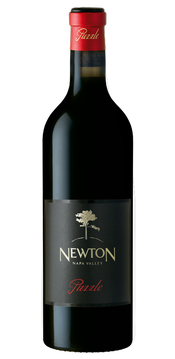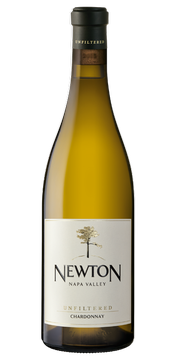 Blancs with perceptible sweetness to me, for example — while others were decent for their price, and just a few I judged to be top-notch. The wines of Newton Vineyards fell into this latter category.
Blancs with perceptible sweetness to me, for example — while others were decent for their price, and just a few I judged to be top-notch. The wines of Newton Vineyards fell into this latter category.
The Newton wines included two Chardonnays — Newton “Unfiltered” Chardonnay from both 2017 and 2016 — and three Cabernets or Cabernet dominant reds. Because Newton is best known for its red wines, I was surprised how much I enjoyed the Chardonnays, although predictably, my favorite wines were the reds.
Newton Vineyards was established by Peter Newton in 1977, and in 2001 LVMH Louis Vuitton Möet Hennessey purchased a controlling stake in the company. The original estate is situated on Spring Mountain, in the Mayacamas Mountains of western Napa Valley, at elevations of 500 to 1600 feet; vineyards occupy less than twenty percent of the property and the remainder is native forest land. This site grows Cabernet Sauvignon and the other Bordeaux red varieties; additional sites owned by LVMH but farmed and harvested only by Newton Vineyards grow more Cabernet and Chardonnay. The past two decades of LVMH ownership included a period of unsuccessful brand expansion followed more recently by a dedicated return to the winery’s roots as an estate producer of high-end wines.
The first Newton Unfiltered Chardonnay dates back to 1990. In those days  “unfiltered” was emerging as a buzzword for wine drinkers, and its use on the labels of the Chardonnay and the Cabernet created a following for these wines. The implications of the word still ring true: fermentations at Newton involve ambient yeasts and similar traditional, low intervention methods including lack of filtration.
“unfiltered” was emerging as a buzzword for wine drinkers, and its use on the labels of the Chardonnay and the Cabernet created a following for these wines. The implications of the word still ring true: fermentations at Newton involve ambient yeasts and similar traditional, low intervention methods including lack of filtration.
The new release of Newton’s Chardonnay is the 2017, but the 2016 is still available in stores. The two wines (both $55) have a similar style, and it is one that I like: they are statuesque Chardonnays, full bodied, dry and firm with creamy rich texture. If you didn’t know that these wines were barrel fermented (with 24 new French oak barrels for the 2016), the smoky and toasty aromas would signal the use of oak, while the creamy texture and fine integration of the oak with the fruit would confirm barrel fermentation rather than just aging of the wine in oak. The wine’s substance and weight owe themselves to the quality of the grapes, to the ambient yeast fermentation, and to lees aging during twelve months of barrel maturation. Besides the smoky aromas and flavors you can expect to find fruit notes of lemon, lemon rind, apple and tangerine, along with notes of honey in the 2016 and savory mineral notes such as wet stone on both vintages. At this moment, I marginally prefer the 2016 because of the complexity it has developed over its additional year of bottle age.
The red wines I tasted were 2017 “Unfiltered” Cabernet Sauvignon ($59), 2016 Mt. Veeder Cabernet Sauvignon ($210) and 2017 The Puzzle, a Bordeaux-grapes blend ($125). I found a common style among these reds, just as I had for the whites: they are exceedingly smooth and caressing in your mouth, with pronounced flavor intensity, good Cabernet varietal character (notes of red cherries, redcurrant, bramble fruits, baking spices, and mineral) and a roundness more typical in Merlot than Cabernet. It is a captivating style that makes the wine quite approachable when it is young.
Personally, I enjoy a leaner style of Cabernet, and for that reason I preferred the Mt. Veeder wine and The Puzzle over the Unfiltered Cabernet. While both of these are smooth and flavorful, the Mt. Veeder 2016 shows striking notes of cedar, graphite and stony minerality along with firm tannins of oak that together give the wine an edginess and somewhat lean structure. Newton’s single-vineyard line also includes a Yountville and a Spring Mountain District Cabernet that I did not taste, and two Chardonnays.
The Puzzle 2017 shows similar aromas to the Mt. Veeder but more obviously, particularly the minerality — along with tobacco, dried herbs and chocolate. Its terrific concentration of fruit anchors the wine’s structure at its core. Despite its richness and welcoming smoothness, it has definition and an authoritative structure. This is a wine you can enjoy even now, although it has the concentration, balance and structure to improve over 15-plus years.
The Puzzle 2017 is 72 percent Cabernet Sauvignon and 15 percent Cabernet Franc with Merlot (7 percent), Petit Verdot (4 percent) and Malbec (2 percent). In 2017, the grapes come from Newton’s Spring Mountain vineyards but also included three parcels of fruit from Yountville and one from Mt. Veeder; the grape blend, the vineyard blend and the winemaking techniques vary each year to reflect the personality of each vintage.
Newton Vineyards “The Puzzle” 2017, 94 Points
Newton Vineyards Mt. Veeder Cabernet Sauvignon 2016, 93 Points
Newton Vineyards “Unfiltered” Chardonnay, Napa Valley, 2016, 92 Points
More by Mary Ewing-Mulligan MW: "On My Table"
